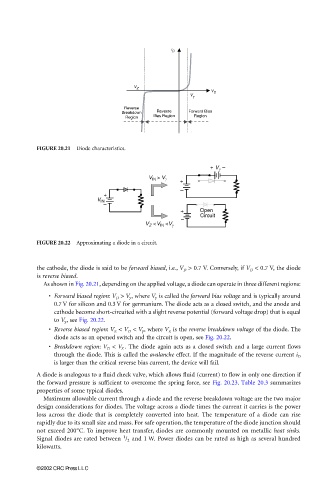Page 545 - The Mechatronics Handbook
P. 545
0066_Frame_C20 Page 15 Wednesday, January 9, 2002 5:41 PM
i D
V Z
V D
Reverse
Breakdown Reverse Forward Bias
Region Bias Region Region
FIGURE 20.21 Diode characteristics.
FIGURE 20.22 Approximating a diode in a circuit.
the cathode, the diode is said to be forward biased, i.e., V D > 0.7 V. Conversely, if V D < 0.7 V, the diode
is reverse biased.
As shown in Fig. 20.21, depending on the applied voltage, a diode can operate in three different regions:
• Forward biased region: V D > V γ , where V γ is called the forward bias voltage and is typically around
0.7 V for silicon and 0.3 V for germanium. The diode acts as a closed switch, and the anode and
cathode become short-circuited with a slight reverse potential (forward voltage drop) that is equal
to V γ , see Fig. 20.22.
• Reverse biased region: V Z < V D < V γ , where V Z is the reverse breakdown voltage of the diode. The
diode acts as an opened switch and the circuit is open, see Fig. 20.22.
• Breakdown region: V D < V Z . The diode again acts as a closed switch and a large current flows
through the diode. This is called the avalanche effect. If the magnitude of the reverse current i D
is larger than the critical reverse bias current, the device will fail.
A diode is analogous to a fluid check valve, which allows fluid (current) to flow in only one direction if
the forward pressure is sufficient to overcome the spring force, see Fig. 20.23. Table 20.3 summarizes
properties of some typical diodes.
Maximum allowable current through a diode and the reverse breakdown voltage are the two major
design considerations for diodes. The voltage across a diode times the current it carries is the power
loss across the diode that is completely converted into heat. The temperature of a diode can rise
rapidly due to its small size and mass. For safe operation, the temperature of the diode junction should
not exceed 200°C. To improve heat transfer, diodes are commonly mounted on metallic heat sinks.
1
Signal diodes are rated between / 2 and 1 W. Power diodes can be rated as high as several hundred
kilowatts.
©2002 CRC Press LLC

